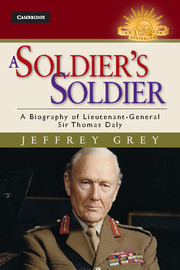Book contents
- Frontmatter
- Contents
- Illustrations
- Maps
- Tables and diagrams
- Acknowledgements
- Abbreviations
- Chapter 1 Regimental soldiering
- Chapter 2 Balikpapan, 1945
- Chapter 3 ‘He could fill any appointment with distinction’
- Chapter 4 The challenges of senior rank
- Chapter 5 Chief of the General Staff
- Chapter 6 Daly, the army and the war in Vietnam, 1966–71
- Chapter 7 The civic action crisis, 1971
- Chapter 8 Epilogue
- Notes
- Sources and Bibliography
- Index
Chapter 6 - Daly, the army and the war in Vietnam, 1966–71
Published online by Cambridge University Press: 05 February 2014
- Frontmatter
- Contents
- Illustrations
- Maps
- Tables and diagrams
- Acknowledgements
- Abbreviations
- Chapter 1 Regimental soldiering
- Chapter 2 Balikpapan, 1945
- Chapter 3 ‘He could fill any appointment with distinction’
- Chapter 4 The challenges of senior rank
- Chapter 5 Chief of the General Staff
- Chapter 6 Daly, the army and the war in Vietnam, 1966–71
- Chapter 7 The civic action crisis, 1971
- Chapter 8 Epilogue
- Notes
- Sources and Bibliography
- Index
Summary
Australia's war in Vietnam was largely an army affair, and within that commitment the largest, hardest and most dangerous part was played by the soldiers of the infantry battalions. Vietnam was the third largest commitment in Australia's history, the longest continuous deployment in a single theatre of operations, and arguably the most complex of Australia's wars at both the military and the policy levels. For Daly as for the army generally, it was the dominant issue on the agenda throughout his period as Chief of the General Staff. ‘Vietnam colours all our thinking and influences practically everything we do’, he wrote to a former subordinate from his Korean War days. ‘It provides us with a clear purpose and to my way of thinking a good and rewarding one. This view is shared wholeheartedly by practically every soldier who has served in that unhappy country and has a first-hand knowledge of the issues and of the values at stake.’ The Vietnam commitment also demonstrated strains and shortcomings in the defence machinery and within the army and in its relationships with the media, some politicians and the wider Australian society.
The decisions over whether to commit forces to Vietnam and what size and shape they would be had been made before Daly became CGS, and he had no involvement in them. As he later recalled, at Eastern Command ‘I wouldn't have known about it until I was informed that the battalion was actually going…I can recall the CGS ringing me one day to inform me that the battalion was going to Vietnam.’ Horner notes in addition that the Defence Committee, for example, did not discuss the Vietnam commitment until April 1965 while Daly himself had noted that the selection of officers and NCOs for service in the AATTV had been left largely to the heads of relevant corps. Once the decision was made, the basis on which the Australians would operate in Vietnam under US aegis was negotiated between the Commander, United States Military Assistance Command Vietnam (COMUSMACV), General William Westmoreland, and the Australian Army's Director of Military Operations and Plans, Brigadier Ken Mackay, with the initial military working agreement being signed between Westmoreland and the new commander of Australian Army Force Vietnam, Colonel O.D. Jackson. This was the structure that oversaw the year-long deployment of 1RAR in 1965–66 and had in-theatre responsibility for the AATTV as well.
- Type
- Chapter
- Information
- A Soldier's SoldierA Biography of Lieutenant General Sir Thomas Daly, pp. 146 - 176Publisher: Cambridge University PressPrint publication year: 2012



